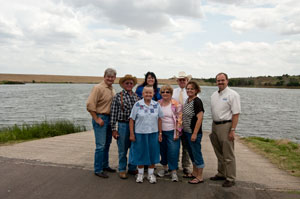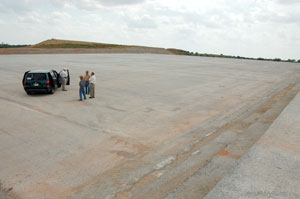Ribbon Cutting held at Crowder Lake, Cobb Creek Watershed Site One
Two-year dam rehabilitation complete.
Submitted by Kristi Hill, Deer Creek Conservation District
Deer Creek Conservation District and Southwestern Oklahoma State University hosted local and state officials at a ribbon-cutting for Cobb Creek Site 1 (Crowder Lake) on July 2, 1012, to officially re-open the facility for all activities. It marks the completion of an approximately two-year, $4.2 million flood control structure rehabilitation project. DCCD and SWOSU are co-sponsors of the project.

Cobb Creek Site 1 was constructed for flood control in 1958 by the Deer Creek Conservation District with assistance of the Oklahoma Conservation Commission and the USDA Natural Resources Conservation Service Watershed Protection and Flood Prevention Program. The dam was originally designed as a low-hazard dam and constructed to protect rural agricultural land from flooding. Because of later development downstream, the dam was reclassified as high hazard in 2006. The dam was rehabilitated to bring it up to current dam safety criteria and extend its life for another 100 years. Rehabilitation included raising the height of the dam, replacing the principal spillway and widening the auxiliary spillway.

Flooding occurred frequently in the watershed before the watershed project was implemented. From 1923 to 1942 there were 13 flood where water covered more than one-half of the watershed flood plain and 67 smaller floods.
In 1983 the Oklahoma Tourism and Recreation Department created a state park around the lake and it became known as Crowder Lake State Park. In 1997 SWOSU took over management of the park and in 2003 the OTRD transferred the lake to SWOSU and it became known as Crowder Lake University Park. Southwestern utilizes the lake in conducting courses such as a ropes course, wilderness first aid, sailing, canoeing, hiking and climbing. What started out as a single-purpose flood control dam has been turned into a great location for college students to learn skills outside the classroom, a recreational area for the university and area citizens, and a lake with enhanced fish and wildlife habitat areas.

Oklahoma leads the nation with a total of 2,105 upstream flood control dams located in 121 watersheds across 64 counties. Collectively, these dams comprise a $2 billion infrastructure that provides multiple benefits to Oklahomans. It is estimated the dams and established conservation practices in the watersheds provide about $74 million in benefits annually by providing flood and erosion control, water for livestock and irrigation, wildlife habitat, recreational areas and flood protection to more than two million acres of agricultural land in downstream flood plains.
The infrastructure also protects 1,532 county and high bridges, prevents floods on 20,541 farms and ranches, traps 9.2 million tons of sediment annually and has created or enhanced 44,399 acres of wetlands. By 2015 more than half of Oklahoma’s dams will have reached or exceeded their designed life span.
Deer Creek Conservation District has three watersheds in its boundaries. Rehabilitation on Cobb Creek Site 2 was completed at the end of 2008 and Cobb Creek Site 3 is currently on the design priority list awaiting funding.
